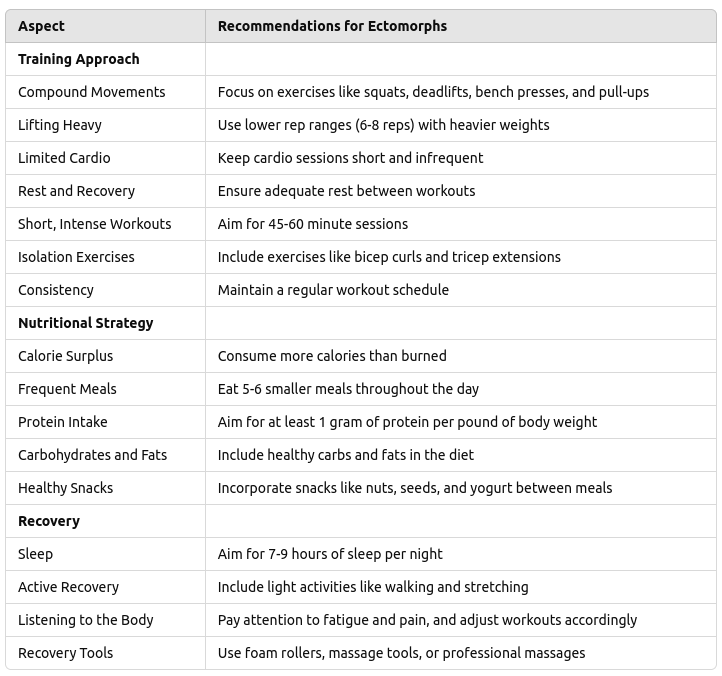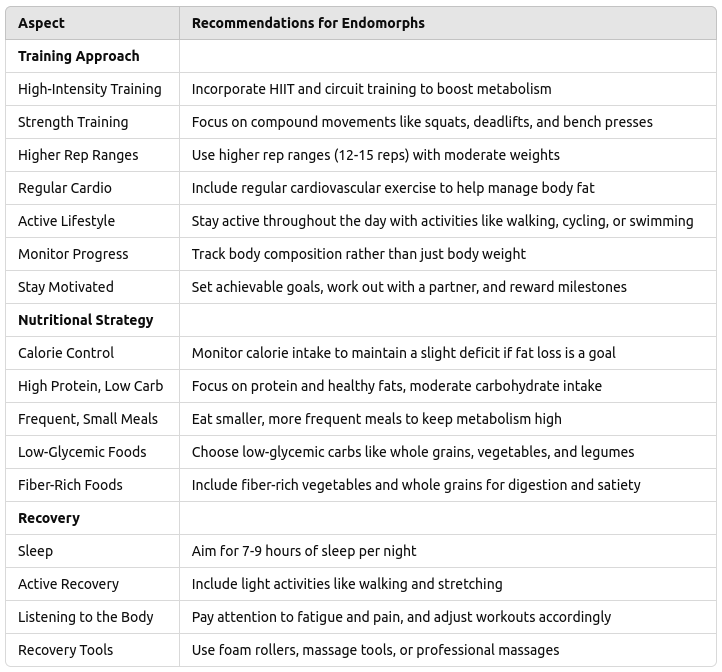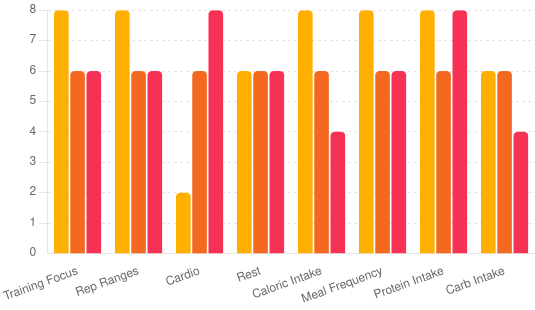When it comes to muscle building, one size does not fit all. Each individual’s body type plays a significant role in how they respond to different training and nutrition strategies. Understanding your body type can help you tailor your workouts and diet to optimize muscle growth and overall fitness. The three primary body types, or somatotypes, are ectomorph, mesomorph, and endomorph. Let’s delve into each type and explore customized approaches to muscle building for each.
Understanding Body Types
Ectomorph
Ectomorphs are typically characterized by a lean and slender frame with long limbs. They have a fast metabolism, making it difficult for them to gain weight and muscle mass.

Training Approach for Ectomorphs:
- Focus on Compound Movements: Prioritize exercises like squats, deadlifts, bench presses, and pull-ups that target multiple muscle groups.
- Lift Heavy: Aim for lower rep ranges (6-8 reps) with heavier weights to stimulate muscle growth.
- Limit Cardio: Too much cardio can burn valuable calories that are needed for muscle gain. Keep cardio sessions short and infrequent.
- Rest and Recovery: Ensure adequate rest between workouts to allow muscles to repair and grow.
Nutritional Strategy for Ectomorphs:
- Calorie Surplus: Consume more calories than you burn to support muscle growth. Focus on nutrient-dense foods.
- Frequent Meals: Eat 5-6 smaller meals throughout the day to keep your metabolism steady and provide a constant supply of nutrients.
- Protein Intake: Aim for at least 1 gram of protein per pound of body weight to support muscle repair and growth.
- Carbohydrates and Fats: Don’t shy away from healthy carbs and fats. They provide the necessary energy for intense workouts.
Mesomorph
Mesomorphs have a naturally athletic build with a well-defined musculature. They tend to gain muscle easily and have a balanced metabolism.

Training Approach for Mesomorphs:
- Balanced Routine: Incorporate a mix of compound and isolation exercises to target both major and minor muscle groups.
- Moderate Volume: Use moderate rep ranges (8-12 reps) and moderate weights to keep muscles challenged.
- Consistent Training: Maintain a consistent workout schedule, balancing strength training with cardiovascular exercise.
- Variety: Regularly change your workout routines to prevent plateaus and keep muscles responsive.
Nutritional Strategy for Mesomorphs:
- Balanced Diet: Eat a balanced diet with a mix of proteins, carbohydrates, and fats to support muscle growth and overall health.
- Adequate Protein: Consume 0.8-1 gram of protein per pound of body weight.
- Hydration: Stay well-hydrated to optimize muscle function and recovery.
- Nutrient Timing: Focus on pre- and post-workout nutrition to fuel workouts and aid recovery.
Endomorph
Endomorphs tend to have a larger, rounder body with a higher percentage of body fat. They often find it easier to gain weight but harder to lose fat.

Training Approach for Endomorphs:
- High-Intensity Training: Incorporate high-intensity interval training (HIIT) and circuit training to boost metabolism and promote fat loss.
- Strength Training: Focus on both compound and isolation exercises, using higher rep ranges (12-15 reps) with moderate weights to build muscle and endurance.
- Cardio: Include regular cardiovascular exercise to help manage body fat.
- Active Lifestyle: Stay active throughout the day, incorporating activities like walking, cycling, or swimming.
Nutritional Strategy for Endomorphs:
- Calorie Control: Monitor calorie intake to ensure you’re in a slight deficit if fat loss is a goal.
- High Protein, Low Carb: Prioritize protein and healthy fats, while moderating carbohydrate intake to prevent excess fat storage.
- Frequent, Small Meals: Eat smaller, more frequent meals to keep metabolism high and avoid overeating.
- Fiber-Rich Foods: Include plenty of fiber-rich vegetables and whole grains to aid digestion and promote satiety.
Tailoring Your Workouts for Maximum Results

Adapting your workout routine to your body type can significantly enhance your muscle-building efforts. Here are some detailed strategies and tips to help you make the most out of your training sessions:
Ectomorph Training Strategies
Prioritize Progressive Overload: Ectomorphs should focus on gradually increasing the weights they lift to continually challenge their muscles. This process, known as progressive overload, is crucial for stimulating muscle growth.
Short, Intense Workouts: Keep your workouts short but intense. Aim for 45-60 minutes per session to avoid overtraining and to maximize muscle recovery and growth.
Isolate Muscle Groups: Include isolation exercises such as bicep curls, tricep extensions, and leg curls to target specific muscle groups and enhance overall muscle definition.
Stay Consistent: Consistency is key for ectomorphs. Stick to a regular workout schedule and avoid skipping sessions to maintain steady progress.
Mesomorph Training Strategies
Mix Up Your Routine: Mesomorphs benefit from a varied workout routine. Incorporate different types of exercises, including strength training, cardio, and flexibility workouts, to keep your muscles guessing and prevent plateaus.
Emphasize Form and Technique: Proper form and technique are crucial for mesomorphs to maximize their muscle gains and prevent injuries. Consider working with a trainer to ensure you’re performing exercises correctly.
Regularly Increase Intensity: Challenge yourself by regularly increasing the intensity of your workouts. This can include adding more weight, increasing the number of sets and reps, or incorporating advanced training techniques like drop sets and supersets.
Balance Strength and Cardio: Ensure a good balance between strength training and cardiovascular exercise. This balance helps maintain muscle mass while keeping body fat levels in check.
Endomorph Training Strategies
Focus on Fat Loss: Endomorphs should prioritize fat loss while building muscle. Incorporate HIIT and circuit training to boost metabolism and burn more calories.
Incorporate Compound Movements: Compound movements such as squats, deadlifts, and bench presses engage multiple muscle groups and help build overall strength and muscle mass.
Monitor Progress: Keep track of your progress by measuring body composition rather than just body weight. This approach provides a more accurate picture of muscle gain and fat loss.
Stay Motivated: Find ways to stay motivated, whether it’s through setting achievable goals, working out with a partner, or rewarding yourself for reaching milestones.
Optimizing Nutrition for Muscle Building
Nutrition plays a pivotal role in muscle building, and each body type requires a tailored approach to diet for optimal results:
For Ectomorphs:
Increase Caloric Intake: Ectomorphs need to consume more calories than they burn. Focus on nutrient-dense foods that provide a balance of macronutrients.
Frequent Protein Intake: Consume protein-rich foods with each meal to support muscle repair and growth. Consider supplements like protein shakes if you’re struggling to meet your protein needs.
Healthy Snacks: Incorporate healthy snacks like nuts, seeds, and yogurt between meals to maintain a steady caloric intake throughout the day.
For Mesomorphs:
Balanced Macronutrients: Mesomorphs should aim for a balanced intake of proteins, carbohydrates, and fats. This balance supports muscle growth and overall health.
Post-Workout Nutrition: Consume a post-workout meal or shake that includes protein and carbohydrates to replenish glycogen stores and promote muscle recovery.
Stay Hydrated: Proper hydration is essential for muscle function and recovery. Aim for at least 8-10 glasses of water a day, and more if you’re engaging in intense workouts.
For Endomorphs:
Control Portion Sizes: Endomorphs should focus on controlling portion sizes to prevent overeating. Use smaller plates and be mindful of serving sizes.
Low-Glycemic Foods: Choose low-glycemic carbohydrates like whole grains, vegetables, and legumes to maintain stable blood sugar levels and avoid fat storage.
High-Protein, Low-Carb Diet: A diet high in protein and low in carbohydrates can help endomorphs build muscle while minimizing fat gain.
The Importance of Recovery
Regardless of your body type, recovery is a crucial component of any muscle-building program. Proper recovery allows muscles to repair and grow, reducing the risk of injury and improving overall performance. Here are some recovery tips:
Get Enough Sleep: Aim for 7-9 hours of sleep per night to support muscle recovery and overall health.
Active Recovery: Incorporate active recovery days with light activities such as walking, stretching, or yoga to promote blood flow and reduce muscle stiffness.
Listen to Your Body: Pay attention to your body’s signals. If you’re feeling overly fatigued or experiencing pain, take a rest day or reduce the intensity of your workouts.
Use Recovery Tools: Consider using foam rollers, massage tools, or professional massages to aid muscle recovery and reduce soreness.
Understanding your body type is crucial for developing an effective muscle-building strategy. By tailoring your training and nutrition to fit your specific needs, you can optimize your muscle growth and achieve your fitness goals more efficiently. Whether you’re an ectomorph, mesomorph, or endomorph, embracing your unique body type and working with it rather than against it will set you on the path to success in your muscle-building journey.

